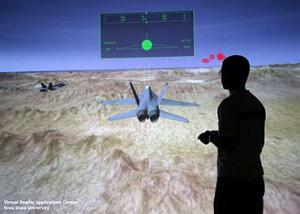A space rock the size of three football fields may have slammed into California more than 35 million years ago, according to a team of scientists that includes a high school student.
The proposed impact may have created the giant 3.4-mile-wide (5.5-kilometer-wide) craterlike formation that the team found buried 4,900 to 5,250 feet (1,490 to 1,600 meters) below sea level west of Stockton, California
Rocks in the potential crater date to about 37 to 49 million years ago.
The formation resembles an impact crater, the researchers said, but they are continuing to analyze rocks from oil exploration wells dug in the region for telltale signs of a collision.
Jared Morrow, an assistant professor of geology at San Diego State University, presented preliminary details of the discovery earlier this month at the Lunar and Planetary Science Conference in Houston, Texas.
China and the US are the countries most vulnerable to damage from future asteroid impacts, according to preliminary new research. Sweden also ranks surprisingly high in this first attempt at quantifying the risks of impact effects, such as tsunamis, on individual nations.
You're high above the desert peaks. Your aircraft are approaching their targets. Information from instruments, cameras and radar is before your eyes. And with the help of 100 million pixels of bright and vivid virtual reality you're in control of a swarm of U.S. Air Force unmanned aerial vehicles.

|
| ©Kevin Teske
|
| Muthukkumar Kadavasal, an Iowa State doctoral student in human computer interaction, demonstrates how improvements to Iowa State's C6 provide virtual reality at the world's highest resolution.
|
Pasadena, Calif. -- An odd, six-sided, honeycomb-shaped feature circling the entire north pole of Saturn has captured the interest of scientists with NASA's Cassini mission.

|
| ©NASA
|
NASA's Voyager 1 and 2 spacecraft imaged the feature over two decades ago. The fact that it has appeared in Cassini images indicates that it is a long-lived feature. A second hexagon, significantly darker than the brighter historical feature, is also visible in the Cassini pictures. The spacecraft's visual and infrared mapping spectrometer is the first instrument to capture the entire hexagon feature in one image.
Comet Lovejoy, discovered just last week by Terry Lovejoy of Thornlands, Australia, is on its way into the solar system. The existence of this lovely green comet was confirmed by John Drummond of Gisborne, New Zealand.
A little under one-third of U.S. households have no Internet access and do not plan to get it, with most of the holdouts seeing little use for it in their lives, according to a survey released on Friday.
Christine McGourty
BBCMon, 26 Mar 2007 22:54 UTC
Scientists believe they have found a new way to track the rise and fall of some ancient civilisations - by studying fossilised mites that thrive in the dung of their livestock.
A team from America, France and Britain have been studying mites from the soil in the Andes in Peru and say the tiny creatures can provide clues to changing patterns of trade and of disease epidemics through history.
Philip Ball
ScienceMon, 26 Mar 2007 11:14 UTC
The wonderful acoustics for which the ancient Greek theatre of Epidaurus is renowned may come from exploiting complex acoustic physics, new research shows.
The theatre, discovered under a layer of earth on the Peloponnese peninsula in 1881 and excavated, has the classic semicircular shape of a Greek amphitheatre, with 34 rows of stone seats (to which the Romans added a further 21).
Its acoustics are extraordinary: a performer standing on the open-air stage can be heard in the back rows almost 60 metres away. Architects and archaeologists have long speculated about what makes the sound transmit so well.
Dan Vergano
USA TodayMon, 26 Mar 2007 11:12 UTC
Biologists and other scientists have long expressed amusement, and gritted their teeth, when they encounter the persistent contention by particle physicists that they alone pursue science in its most pure state. "Particle physics is the most fundamental area of science in that its goal is to reduce the wonderful diversity and complexity of our universe to a few simple mathematical laws," wrote the noted physicists Sylvester James Gates, Jr. and Warren Siegel, two decades ago, expressing a truism often shared by those in their discipline.
What's worse for the long-suffering biologists, physics has long started reaching into others' fields, spawning disciplines such as biophysics, and even taken on subjects such as sociology, the far reaches of messy "soft" sciences.
But maybe the physicists have it backwards, suggests one well-known biologist, embryonic stem cell scientist Robert Lanza of Advanced Cell Technology, writing in the current issue of The American Scholar, a quarterly brought to you by the folks at Phi Beta Kappa. Maybe the world is the product of one aspect of biology, the mind, and not the other way around, he argues. "As we have seen, the world appears to be designed for life not just at the microscopic scale of the atom, but at the level of the universe itself," Lanza writes. What if, Lanza asks, this means that instead of infinitesimally tiny particles creating space and time (and making life possible), "the brain can really create physical reality."
French political debate is shifting from Left Bank cafes and being teleported into cyberspace.
Instead of agreeing to disagree over a glass of kir, many French youths are sending their ideas flying through the computer-animated world of Second Life.
"In here, you can see French people expressing themselves as they ought to, instead of being the hypocrites they often are in real life," said an avatar, or computer image, of what appeared to be a woman using the Second Life moniker of Hayahaya Milo.
